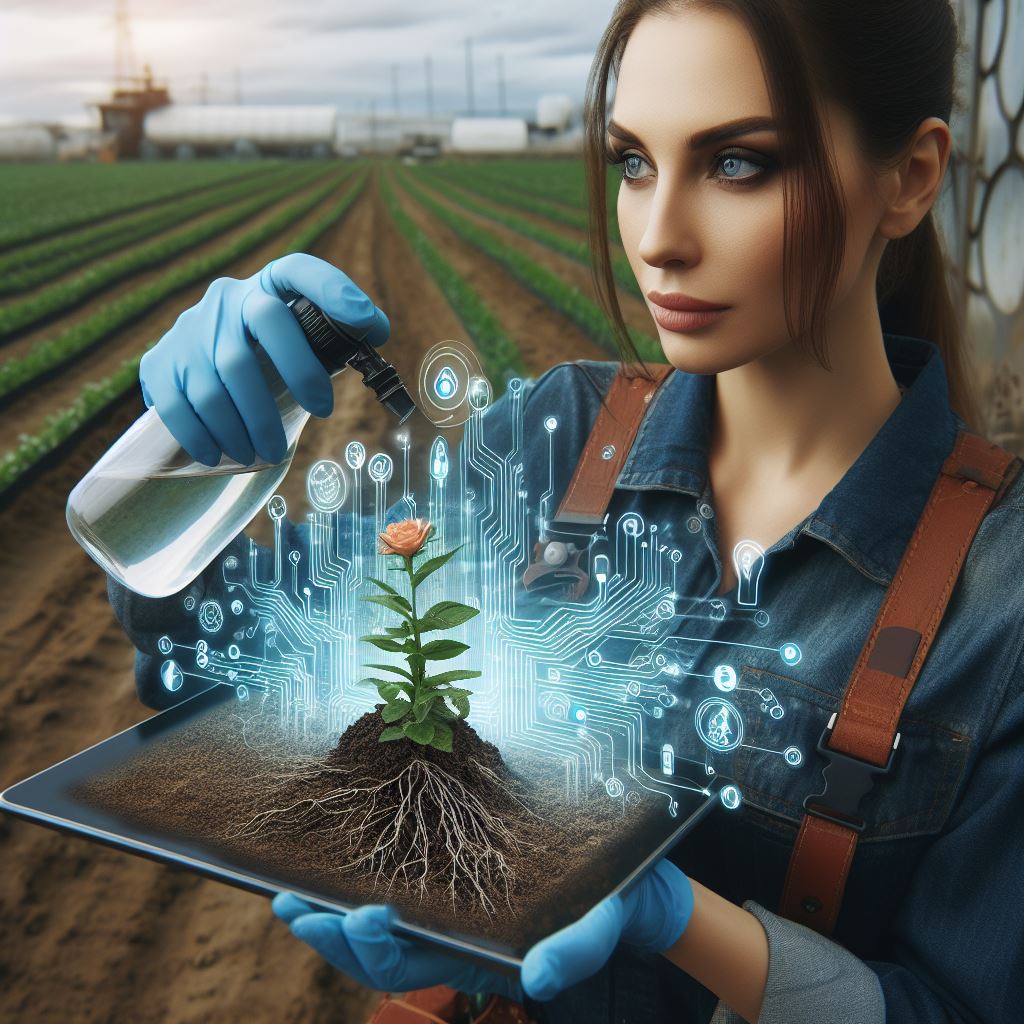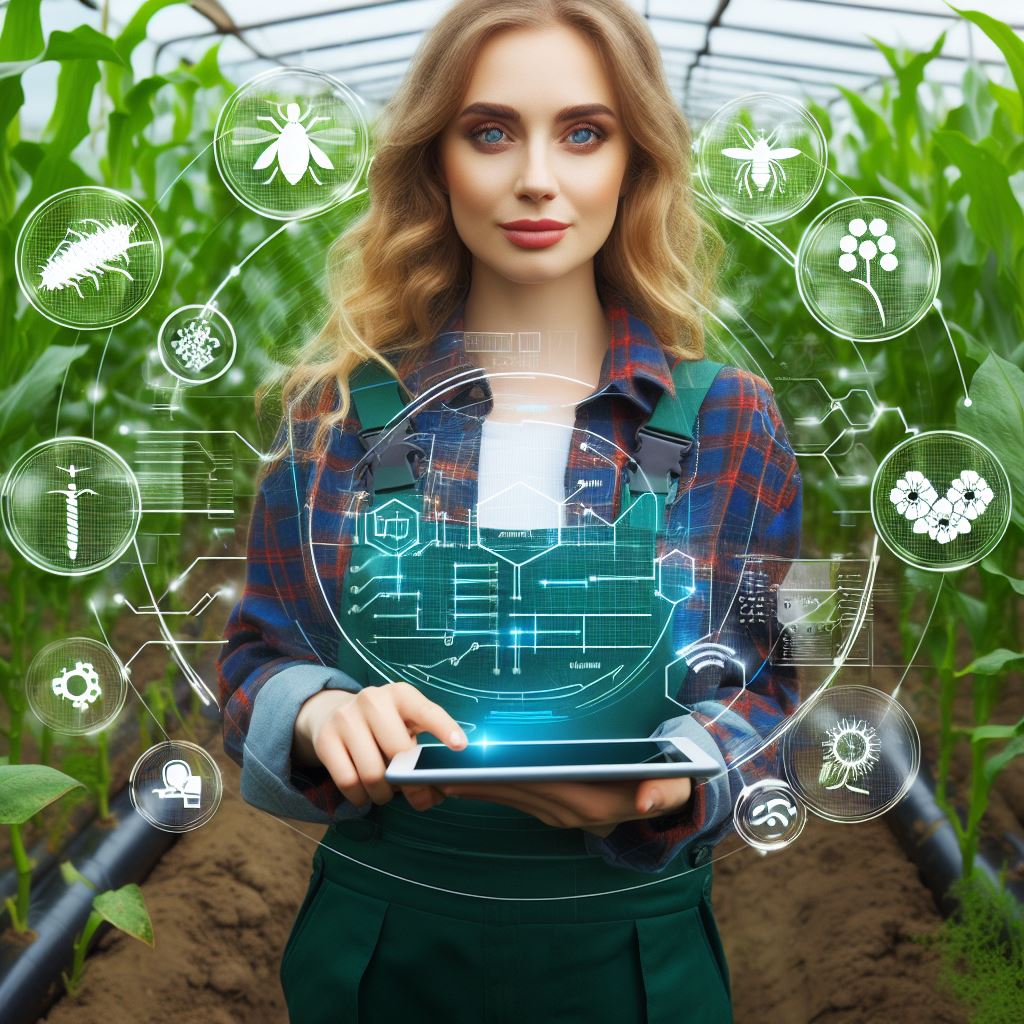Introduction
Soil health is a vital aspect of sustainable agriculture, as it directly affects crop production, environmental sustainability, and overall ecosystem health.
Healthy soil is rich in organic matter, nutrients, and beneficial microorganisms, providing a strong foundation for plant growth.
It plays a crucial role in nutrient cycling, water filtration, and carbon sequestration.
With the rapid advancements in technology, agriculture has undergone a significant transformation.
Technology has revolutionized the way farmers manage their land, including soil health management. Innovative tools and techniques have been developed to monitor and maintain soil health efficiently.
Precision agriculture is one such technological advancement in this field.
It utilizes sensors, remote sensing, and global positioning systems (GPS) to collect real-time data about soil conditions and crop performance.
Farmers can monitor crucial parameters such as nutrient levels, soil moisture, and pH, enabling them to make informed decisions about fertilizer application and irrigation.
Technology has enabled the creation of smart farming systems that integrate soil health monitoring with other aspects of crop management.
These systems use artificial intelligence and machine learning algorithms to analyze data and provide customized recommendations for farm-specific practices.
This helps optimize resource utilization while reducing environmental impact.
The use of drones for soil mapping and monitoring is another game-changing innovation.
Drones equipped with advanced cameras and sensors can capture high-resolution images and collect detailed information about soil properties.
This data can contribute to precision agriculture by identifying areas of nutrient deficiency or soil erosion, allowing farmers to take targeted actions to improve soil health.
In fact, technology has a crucial role in advancing soil health management in agriculture.
These innovations not only enhance crop productivity but also promote sustainable farming practices by reducing inputs, minimizing environmental impacts, and ensuring long-term soil health.
By embracing these technological advancements, farmers can maximize their yields while contributing to the preservation of our precious soil resources.
Traditional soil management practices
Types of traditional practices
- Crop rotation: Farmers alternate different crops on the same land to maximize productivity and minimize pests.
- Terracing: Building stepped flat areas on slopes to prevent soil erosion and increase water retention.
- Contour farming: Plowing along the contours of the land to slow down water runoff and reduce soil erosion.
- Cover cropping: Planting specific crops that protect the soil from erosion, fix nitrogen levels, and improve soil organic matter.
- Conservation tillage: Reducing the intensity of tilling or eliminating it altogether to preserve soil structure and reduce erosion.
Challenges and limitations of these practices
- Labor-intensive: Traditional practices often require significant manual labor, making them difficult to scale up.
- Knowledge and awareness: Lack of knowledge about the benefits of these practices can impede their adoption.
- Cost: Some traditional practices, such as terracing, can be expensive to implement and maintain.
- Climate limitations: Certain traditional practices may be less effective in extreme climates or unsuitable soil conditions.
- Resistance to change: Familiarity with conventional methods can make it challenging for farmers to embrace new practices.
Impact on soil health
- Soil erosion control: Traditional practices like terracing and contour farming minimize erosion, which helps maintain soil health.
- Nutrient retention: Crop rotation and cover cropping improve nutrient cycling and reduce the need for synthetic fertilizers.
- Organic matter enrichment: Conservation tillage and cover cropping increase soil organic matter, enhancing soil fertility and structure.
- Water infiltration: By slowing down water runoff, traditional practices improve water infiltration and reduce the risk of drought.
- Pest management: Crop rotation disrupts pest life cycles, reducing the need for chemical pesticides and promoting biological pest control.
In short, traditional soil management practices play a crucial role in maintaining soil health.
Despite their challenges, these practices can significantly enhance soil fertility, reduce erosion, and improve water and nutrient management.
The limitations of traditional practices make it necessary to explore technological innovations to further advance soil health management.
Read: Greenhouse Growing: Tips for Better Yields
Emerging technologies in soil health management
In recent years, there has been a rapid development and adoption of innovative technologies in soil health management.
These advancements aim to enhance agricultural practices, optimize resource utilization, and promote sustainable soil management.
In this section, we will explore some emerging technologies that play a crucial role in revolutionizing soil health management.
Precision agriculture and soil mapping
Precision agriculture, also known as site-specific farming, combines geospatial data and technology to enable more efficient and targeted soil management.
One of the key tools in precision agriculture is the use of geographic information systems (GIS).
GIS integrates various data sources such as satellite imagery, soil sample analysis, and weather data to create detailed soil maps.
By analyzing these maps, farmers can identify variations in soil properties and make informed decisions regarding nutrient application, irrigation, and crop selection.
This approach minimizes the risk of overuse or underuse of resources, leading to improved soil health and increased crop yields.
Another significant development in precision agriculture is the use of soil sensors and monitoring devices.
These devices are strategically placed in the field to measure key soil parameters, including moisture content, nutrient levels, and pH levels.
Real-time data collected by these sensors provide valuable insights into soil conditions and allow farmers to make timely adjustments in their management practices.
For example, sensors can detect areas with low moisture levels, triggering automated irrigation systems to deliver water precisely where it is needed.
By monitoring and responding to real-time data, farmers can optimize resource allocation, reduce input costs, and ensure healthy soil conditions for optimal crop growth.
Big data and predictive analytics for soil health
The advent of big data and predictive analytics has revolutionized many industries, including agriculture.
In soil health management, the collection and analysis of large amounts of data play a pivotal role in understanding soil dynamics and trends.
With sophisticated data collection systems, farmers can gather information on soil moisture, temperature, nutrient levels, and crop growth patterns, among other variables.
By analyzing this data using advanced statistical models and algorithms, predictive analytics can reveal valuable insights and patterns that aid in proactive soil management.
These predictive models enable farmers to forecast soil conditions and take preventive measures to ensure optimal soil health.
For instance, analytics can predict the likelihood of soil erosion or nutrient depletion based on historical records and current environmental factors.
Armed with this information, farmers can implement measures to prevent erosion by adopting conservation practices such as cover cropping or contour plowing.
Predictive analytics can guide farmers in adjusting nutrient application rates to maintain soil fertility and minimize nutrient runoff, leading to better soil quality and reduced environmental impact.
Robot-assisted farming and automated tools
The integration of robotics and automation in soil health management has opened new avenues for enhancing agricultural practices.
Drones and robots equipped with various sensors and imaging technologies are being used to collect high-resolution data, monitor crop health, and assess soil properties.
By deploying drones, farmers can rapidly gather data over large areas, identifying stress or disease patterns, nutrient deficiencies, and water management issues.
This information helps them make timely intervention decisions, addressing potential soil health problems before they compromise crop productivity.
Automation also offers significant advantages in various soil management tasks.
Automated tools such as precision seeders, fertilizer applicators, and robotic weed control systems can precisely distribute resources according to soil conditions.
This targeted approach minimizes waste, reduces input costs, and optimizes resource utilization.
Furthermore, automation reduces labor requirements and enhances operational efficiency, allowing farmers to streamline their workflows and allocate their human resources more effectively.
Transform Your Agribusiness
Unlock your farm's potential with expert advice tailored to your needs. Get actionable steps that drive real results.
Get StartedIn a nutshell, emerging technologies in soil health management, including precision agriculture, big data analytics, and robot-assisted farming, are transforming traditional agricultural practices.
These innovative solutions enable farmers to make informed decisions, optimize resource allocation, and promote sustainable soil management.
By harnessing the power of technology, we can foster healthier soils, increase crop yields, and ensure a more sustainable future for agriculture.
Read: Crop Rotation Benefits: A Sustainable Practice

Discover More: Greenhouse Farming in a Changing Climate
Impact of technology on soil health
Technology has emerged as a critical component in revolutionizing agriculture practices and soil health management.
The impact of technology on soil health has been profound and aims to optimize soil fertility, reduce soil erosion and compaction, and enhance water management practices.
Improved soil fertility and nutrient management
One of the major contributions of technology is in improving soil fertility and nutrient management.
Precision application methods allow farmers to target and deliver fertilizers and amendments precisely, minimizing wastage and reducing environmental pollution.
This precision not only ensures cost-efficiency but also minimizes the excess accumulation of nutrients in soils, a problem common with traditional application methods.
Technology-based solutions optimize nutrient uptakes by crops, leading to better utilization of fertilizers and increased soil fertility.
Reduced soil erosion and compaction
Another significant impact of technology is in reducing soil erosion and compaction. Improved tillage practices, facilitated by technology, help farmers implement conservation tillage methods.
These methods aim to minimize soil disturbance, promote root development, and enhance water infiltration.
By reducing soil erosion, these practices preserve topsoil and maintain soil structure, ultimately contributing to better soil health.
Technology also plays a vital role in preventing soil degradation and compaction.
Modern practices that employ technology, such as controlled traffic farming and GPS-guided equipment, minimize soil compaction caused by heavy machinery.
By reducing soil compaction, farmers can maintain soil porosity, which promotes root growth and allows for better nutrient and water uptake by plants.
This integration of technology helps in preserving soil health and fertility for sustainable agriculture.
Enhanced water management
Enhanced water management is another important aspect where technology has made significant contributions.
Efficient irrigation techniques, such as drip irrigation and precision sprinklers, aid in the controlled application of water.
By delivering water directly to the roots, these techniques ensure optimal water use and reduce water loss through evaporation or runoff.
Technology enables real-time monitoring of soil moisture levels, enabling farmers to adjust irrigation schedules accordingly.
This precision in water management helps in conserving water resources and avoiding over-irrigation, which can lead to waterlogging and nutrient leaching.
In general, technology has positively impacted soil health management in various ways.
Through precision application of fertilizers and amendments, it ensures improved soil fertility and nutrient management.
By promoting conservation tillage practices and preventing soil degradation, technology aids in reducing soil erosion and compaction.
Additionally, technology-based solutions enhance water management practices, leading to efficient irrigation and water conservation.
The integration of technology in soil health management has immense potential to transform agricultural practices and ensure sustainable, thriving soils for future generations.
Read: Managing Pests in Organic Vegetable Farms
Challenges and Future Prospects
Cost and Accessibility of Technology
- The high cost of soil health technology remains a key challenge for widespread adoption.
- Accessibility to these technologies in developing regions with limited resources is also an issue.
- Efforts should be made to bring down the cost and increase accessibility to promote usage.
- Funding and support from governments, NGOs, and private sector can help address this challenge.
- Collaborations and partnerships between technology developers and farming communities can foster solutions.
Integration with Existing Farming Practices
- Successful integration of soil health technology with traditional farming practices is crucial for acceptance.
- Farmers may be resistant to change if new technologies disrupt their established workflows.
- Education and training programs can help farmers understand the benefits and ease of adoption.
- Providing technical assistance and on-farm demonstrations can facilitate smooth integration.
- Real-life success stories of farmers who have benefitted from the technology can provide inspiration.
Potential for Further Innovations in Soil Health Tech
- The field of soil health technology is constantly evolving with room for further innovations.
- There is a need to develop advanced sensors and monitoring systems for accurate and real-time soil health data.
- Integration of artificial intelligence and machine learning algorithms can enhance data analysis and interpretation.
- Development of user-friendly mobile applications can enable easy access and interpretation of soil health information.
- Exploration of new techniques and methods, such as genetic engineering and bio-based solutions, can revolutionize soil health management.
In closing, while there are challenges in terms of cost, accessibility, and integration, the future prospects of soil health technology are promising.
Efforts to reduce costs and enhance accessibility, along with education and support, can drive its adoption.
The potential for further innovations in soil health tech, including advanced sensors and AI integration, presents exciting possibilities for sustainable agriculture.
By addressing these challenges and fostering continued development, the role of technology in soil health can greatly contribute to global food security and environmental sustainability.
Read: Climate Impact on Potato Growth: What to Know
Conclusion
Recap of the importance of soil health and technology’s role
Soil health is crucial for sustainable agriculture, and technology plays a vital role in improving it.
Through precision farming techniques, farmers can monitor soil conditions and make informed decisions to optimize crop yield and conserve resources.
Encouragement to farmers to embrace innovative soil health technologies
Farmers must embrace and adopt innovative soil health technologies to secure the future of agriculture.
By investing in advanced sensors, drones, and data analytics, they can effectively manage soil nutrients, prevent erosion, and reduce chemical inputs.
Taking advantage of these technological advancements will result in healthier soils, increased productivity, and improved environmental sustainability.
By prioritizing soil health, farmers can mitigate the effects of climate change and ensure food security for future generations.
It is essential for farmers to keep abreast of the latest advancements and collaborate with tech providers and research institutions.
Governments should also support them through policy incentives, subsidies, and knowledge-sharing platforms.
The integration of technology in soil health management is revolutionizing the agricultural landscape.
By leveraging these innovations, farmers can optimize their operations, protect the environment, and contribute to a more sustainable future.
Embracing innovative soil health technologies is not just beneficial for individual farmers but also for the entire global population’s well-being.
Let us all work together to nourish our soils and secure a prosperous future for agriculture.




